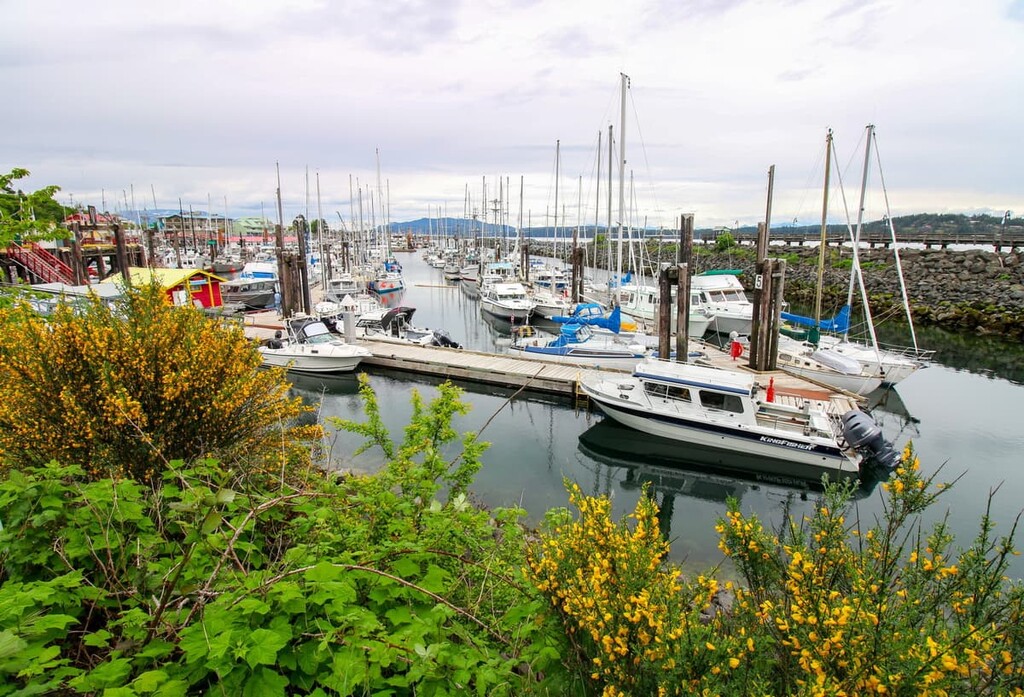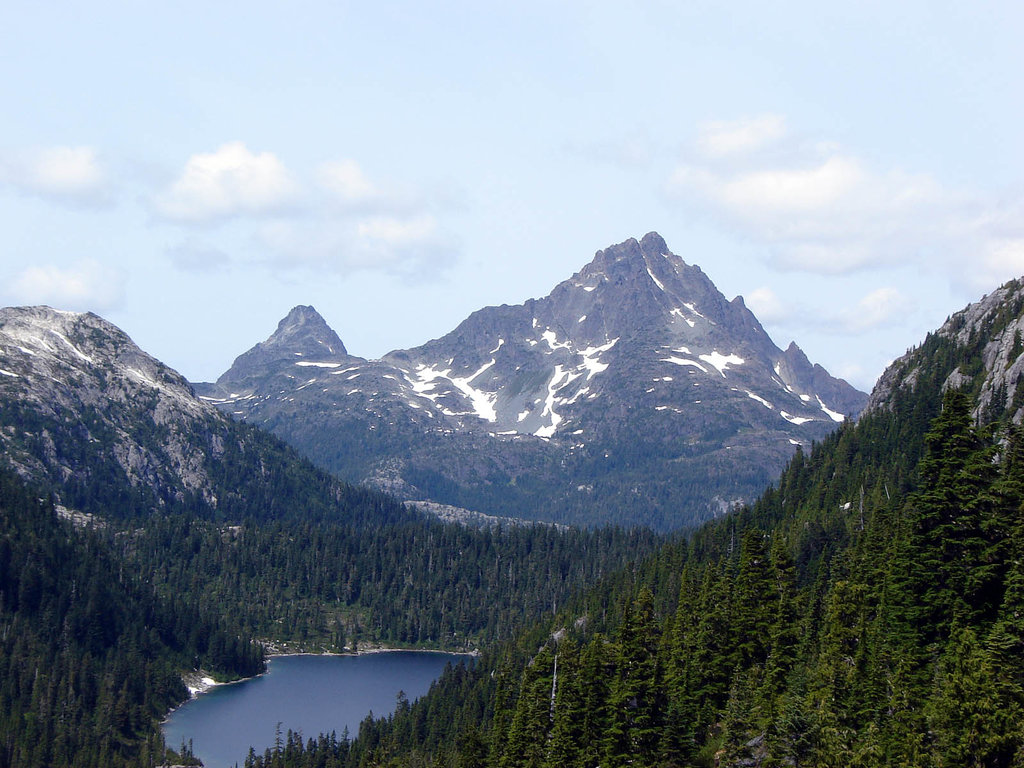Get PeakVisor App
Sign In
Search by GPS coordinates
- Latitude
- ° ' ''
- Longitude
- ° ' ''
- Units of Length

Yes
Cancel
Share ×

Scan the QR code and open PeakVisor on your phone
❤ Wishlist ×
Choose
Delete
The Franklin Range is a collection of peaks that’s located in the Regional District of Mount Waddington on the north end of Vancouver Island in British Columbia, Canada. The range contains 5 named peaks, the highest and most prominent of which is Tsitika Mountain at 1,657 m (5,436 ft) in elevation and with 797 m (2,615 ft) of prominence.
Located on the north end of Vancouver Island in British Columbia, Canada, the Franklin Range is a group of mountains that borders the Johnstone Strait and occupies the land between the Kokish and Tsitika rivers. The Franklin Range is located adjacent to the Bonanza Range and the Hankin Range.
There are only four named mountains in the range, the highest and most prominent of which is Tsitika Mountain at 1,657 m (5,436 ft) in elevation and with 797 m (2,615 ft) of prominence.
Within the range, there are a number of notable parks and protected areas. For example, Tsitika Mountain Ecological Reserve, Robson Bight Ecological Reserve, and Lower Tsitika River Provincial Park are found on the southern end of the Franklin Range. Other nearby parks and land reserves include:
The Franklin Range is a subrange of the Vancouver Island Ranges, which themselves are a subrange of the Insular Mountains. The Insular Mountains form parts of the mainland mountains in southwestern British Columbia, southern Alaska, Vancouver Island, and the archipelago of Haida Gwaii.
Formed from an ancient terrane called Wrangellia, the Insular Mountains feature many different geologic formations. Wrangellia started forming over 300 million years ago from lava that erupted from a rift in the floor of the Pacific Ocean. For millions of years, sediments accumulated upon the volcanic rock; however, the majority of the terrane was created about 230 million years ago.
The rifts in the seafloor opened again about 230 million years ago, causing volcanic eruptions in the process. These eruptions continued for about 5 million years and created the major 6 km (3.6 mi) thick layer of basaltic lava rock that composes most of the Wrangellia terrane.
During the Late Jurassic and Early Cretaceous, about 145 million years ago, Wrangellia collided with the continent of North America. This collision caused the major tectonic uplift that created the Rocky Mountains. It was also responsible for much of the uplift of the Columbia and Coast Mountains.
As Wrangellia’s tectonic plate subducted beneath the western edge of North America, the terrane accreted to the edge of the continent. During the accretion, the Wrangellia terrane was compressed, folded, and broken apart. These geologic events started the formation of the Vancouver Island Ranges.
The final uplift of the Vancouver Island Ranges, which includes the Franklin Range, was caused by the collision and accretion of the additional Pacific Rim and Crescent Terranes. The Pacific Rim terrane accreted to the continent about 60 million years ago while the Crescent terrane accreted about 45 million years ago.
While the major topographical features in the range were completed after the collision of the Crescent Terrane, the glaciers and ice sheets of the Pleistocene were responsible for carving out the shape of the peaks that we see in the region to this day.
During the Pleistocene, ice sheets formed from the mountain peaks at the center of the island near what is now Strathcona Provincial Park. Local glaciers were also nestled among the tall peaks in each range, carving out cirques and steepening the sides of the region’s valleys.
There were several occurrences of the ice sheet expansion from the mainland, all of which helped to cover Vancouver Island in over 1 kilometer (0.6 mi) of ice over the course of millions of years.
During their retreat, the glaciers also deposited massive amounts of debris and sediment across the landscape. As a result, the valleys of the Franklin Range have layers of glacial sediment and till that date back to this period of glacial retreat.
Mountain hemlock and amabilis fir are the dominant tree species found on the upper slopes and peaks of the Franklin Range, alongside some stands of yellow cedar. At the highest elevations of the zone, the forest thins out to create a parkland-like mosaic of distinct grassy meadows and stands of trees.
The Franklin Range is located at the north end of Vancouver Island, which is where the elevation of the mountains tapers off. As such, there is only minimal representation of the region’s typical alpine ecosystems in the range.
The lower slopes and valleys of the Franklin Range are covered in forests typical of the Western Hemlock ecosystems, which are part of the northern temperate rainforests. Western hemlock and amabilis fir are the dominant trees on the lower slopes in the range. However, most visitors will recognize the giant red cedars, towering Douglas firs, and massive Sitka spruces, which are all major features of any of the old-growth forests in the region.
The Franklin Range is inhabited by many animal species, such as the Columbian black-tailed deer, Vancouver Island gray wolf, and black bears. Eagles are a particularly majestic sight in the range as they soar around the mountain peaks. However, many other small mammal and bird species are also present in the range.
Vancouver Island is divided into three regions that have been traditionally occupied by the Coast Salish, Nuu-chah-nulth, and the Kwakiutl. The Franklin Range is located along the border of the traditional territory of the Coast Salish and Kwakiutl.
Archeological evidence suggests that Vancouver Island has been home to humans for at least 13,000 years. Many First Nations in the region have a cultural legend that tells of a major flood that occurred in the region. While many people were washed away by this flood, some survived the flood by retreating to canoes that they tied to trees.
Changing sea levels since the Pleistocene have made it difficult to find evidence of older human habitation in the region. Ancient First Nations communities in the region tended to cluster along the coast; however, at the beginning of the Holocene, sea levels were significantly lower.
As a result, many places that would have been settled by First Nations are now underwater. Indeed, some cultural sites have been uncovered in the waters near Haida Gwaii.
Within the borders of Lower Tsitika River Provincial Park, there are the remains of an ancient village site as well as culturally significant areas for many regional First Nations. The coastal area along the eastern slopes of the range and the area along the Tsitika River both have especially long histories of use and occupation by First Nations.
Despite its proximity to several major communities and cities on Vancouver Island, the Franklin Range is relatively untouched and untrodden. While few people tend to hike in the Franklin Range, those that make the effort to do so are often rewarded with breathtaking views.
The most accessible mountains in the Franklin Range are the three peaks located at the south end of the range: Tsitika Mountain, Mount Sir John, and Wosscairn. While the hike up Mount Sir John is relatively straightforward and gentle, both Wosscairn and Tsitika Mountain require a bit of a scramble to reach the summit.
Upon reaching any of these summits, hikers are rewarded with views of the Bonanza Range, Johnstone Strait, and Robson Bight. The summit of Wosscairn has a massive cairn, too, that was likely built by the 1931 survey crews, as they could see it from adjacent peaks to make triangulation calculations.
The Franklin Range is accessible via forestry roads that branch from Highway 19. The range has ecologically sensitive areas where hikers are prohibited; however, there are still many worthwhile destinations. The following are some of the major towns and cities that offer services near the Franklin Range.
Campbell River is the largest community on the north end of Vancouver Island, and it is located about 140 km (86 mi) from the Franklin Range. Situated along the Campbell River and the Georgia Strait, the city is the gateway to the Discovery Islands and the northern Vancouver Island wilderness.
The beaches of Campbell River offer stunning views into the Georgia Strait toward the Pacific Ranges on the mainland as well as toward Quadra Island, Cortes Island, and many of the other islands that make up the Discovery Islands. However, it should be noted that the winter months are typically cloudy, foggy, and quite dreary in Campbell River. The summer months are certainly the most favorable time to visit the city.

That being said, there are many incredible sites and hikes around Campbell River. It’s nice to hike to the falls at Elk Falls Provincial Park, take pictures of the falls from the suspension bridge, and admire the massive cedar and Douglas fir trees. It is also nice to walk along and enjoy the beautiful beaches where you can sit on volcanic outcrops, cobble rocks, or soft sand.
There are many great hikes and walks in and near the city; however, there are many more options that are located only a short drive or a ferry ride away. Strathcona Provincial Park, Mount Arrowsmith Massif Regional Park, and Schoen Lake Provincial Park are all beautiful places to visit near Campbell River, and the drive from the city takes you along the scenic highway.
Further adventuring around Campbell River can be done in the Discovery Islands, of which Quadra Island is just a short ferry ride away. Or, another ferry can take you to Cortes Island where you can hike through the picturesque Ha’thayim Marine Provincial Park. To fully appreciate all that the islands have to offer, consider staying at hotels or campsites and taking a couple of days to travel through the region.
Port McNeill is the gateway to the scenic islands of Broughton Archipelago. It offers regular ferry service to Alert Bay on Cormorant Island and Sointula on Malcolm Island. The town is located about 50 km (30 mi) to the northwest of the Franklin Range.
Some of the many amazing places to visit in and around the community of Port McNeill include the scenic islands of the Broughton Archipelago, where there are several marine provincial parks.
Here, you can also check out Nimpkish Lake Provincial Park and the beautiful Cape Scott Provincial Park. The wilderness, beaches, and seaways of north Vancouver Island are all beautiful and are full of opportunities for adventure.

Explore Franklin Range with the PeakVisor 3D Map and identify its summits.


